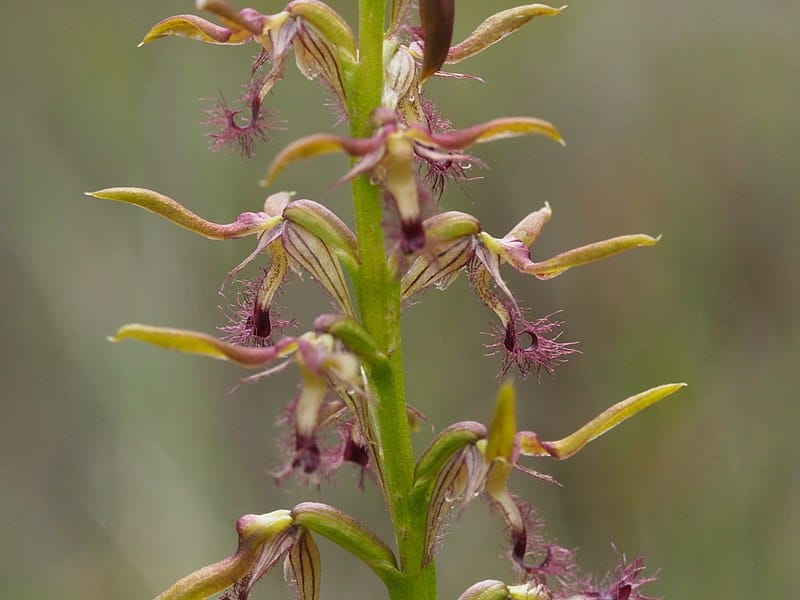
Plumed midge-orchid Facts
- The uniquely descriptive term of Plumed midge-orchid serves as the most frequently used common name for this intriguing marvel of Nature. That’s certainly not the plant’s only generally used moniker, though. It’s also sometimes known as the Tallong midge-orchid.
- Within scientific circles, however, it sometimes goes by a far different term. Unfortunately, it’s quite a hard one for the layperson to pronounce. That’s because this flora bears the formal name of the Geneplesium plumosum. Regardless of the term chosen, it’s a remarkable plant.
- The first formal description of the very rare flower did not take place until the year 1942. This action occurred as a result of a detailed exploration of the area in which it appears. Clergyman and botanist Herman Rupp became the first to scientifically identify and classify the species.
- Unfortunately, most specimens of the remarkable Angiosperm only inhabit an extremely miniscule area. However, a handful of individual plants do also appear inside the Morton National Park. Fortunately, this location serves to provide them with a measure of protection.
- Researchers estimate the total population of the Plumed midge-orchid to be no only a few hundred. Due to this extremely unfortunate fact, the IUCN understandably presently lists the species as Endangered. In addition to other factors, it now faces the threat of climate change.
Related Articles
Plumed midge-orchid Physical Description
The gorgeous Plumed midge-orchid distinguishes itself from its many kin in a specific combination of ways. That’s partly due to the fact that this species evolved as a somewhat unique variety of terrestrial perennial. But, the truly amazing lifeform also evolved both fine roots and tubers.
Yet, Nature did not simply stop at this point with this botanical wonder. The tubers it develops also have a secure protective covering, and often extend all the way up to the surface. It’s also classified as what’s known as a ground orchid, since the Angiosperm rarely exceeds (12 in 30 cm) in height.
The remarkable floral variety does produce multiple short stems, however. Each of these features additionally contains a quantity of flowers that ranges from 1-6. These blooms present a dazzling array of hues. That pattern generally consists of a light green, with stripes of pink and purple.
The foliage of the Plumed midge-orchid fully merits appreciation by the viewer as well, though. While relatively small in size, the leaves of the distinctive plant actually end directly below the flowers themselves. Also uniquely, the delicate petals themselves have a covering of fine hairs.
Evolution further provided well for its chances of procreation. That’s true due to the distinctive nature of the seeds the Angiosperm generates. The non-fleshy fruit it produces forms as a comparatively small capsule. Despite its diminutive size, though, this contains hundreds of seeds.
- Kingdom: Plantae
- Phylum: Angiosperms
- Class: Monocots
- Order: Asparagales
- Family: Orchiaceae
- Genus: Genoplesium
- Species: G. plumosum
Plumed midge-orchid Distribution, Habitat, and Ecology
Where this wonder of creation resides won’t surprise many people. That’s because the amazing Plumed midge-orchid evolved as native to a region of the globe already quite renowned for its incredible abundance of life. This species developed as native to the continent of Australia.
Even there, though, this botanical wonders’ range remains extremely restricted. Sadly, excepting a few scattered plants in a National Park, the majority of this range consists of a tiny area. This only covers a range of 8 sq mi (20 sq km). This occupies a remote section of New South Wales.
Inside that incredibly tiny region, its known habitat remains completely restricted to only the area known as the Southern Tablelands. This naturally led it to develop a set of very precise habitat requirements. As a result, it mainly lives amid sections of low shrubs, within the confines of a forest.
Yet the beautiful and surprisingly versatile Angiosperm nonetheless does show at least some flexibiltiy in this respect. Due to that admittedly small versatility, the plant occasionally inhabits a few other areas. These alternate sites sometimes include such as moss gardens and parks, as well.
The Plumed midge-orchid also has an unusual blooming cycle. That’s because the extraordinary species typically blooms roughly 4-6 weeks after a period of rain. This occurs in either the summer or the autumn seasons. This represents yet another way in which it distinguishes itself from others.
Unfortunately, numerous factors appear to be hampering its chances for continued survival. One reason for its decline appears to be the clearing of land for human usage. Another reason seems to be overgrazing by an introduced rabbit species. Conservation efforts are thankfully ongoing.
Species Sharing Its Range
Check out our other articles on 6 Startling Evolutionary Adaptations, Pudu, Stromboli, Adenium Flower Bonsai, Knysna Dwarf Chameleon, Thresher Shark, Mitchell’s Satyr Butterfly, Little Auk
